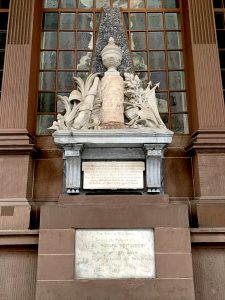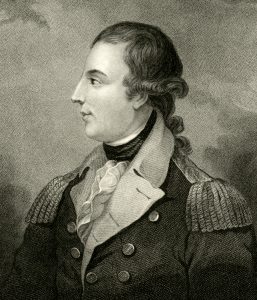Almost forty years ago, I led a team of nautical archaeologists in the study of the steamboat Phoenix, which had burned on Lake Champlain the night of September 4, 1819. In researching the Phoenix’s history, I came across the reference that “in July, 1818 the remains of General Richard Montgomery, the dashing American leader who fell in 1775 in the futile expedition against Quebec were borne through the lake on board the Phoenix, the vessel being draped in mourning and her colors at half-staff.”[1] Since then my research on the history of the Revolutionary War on Lake Champlain has led me to understand the importance of the greatest sacrifice General Montgomery made while attempting to capture British Canada early in the war. As he fought for his adopted nation, Gen. Richard Montgomery’s life ended in a fury of cannon-fire and snow on New Year’s Eve, 1775. In the aftermath, Congress and his widow Janet simply asked that he be remembered for his sacrifice.

As July 8, 2018 marked the 200th anniversary of his re-internment at St. Paul’s Chapel, it felt right to remember his story. I recently had the opportunity to visit his final resting place at St. Paul’s Chapel in New York City.
St. Paul’s Chapel is now remembered more for surviving the 9/11 attacks and providing refuge for the workers at Ground Zero than for being the grave site and monument of General Montgomery. As I approached the Chapel to spend some quiet time with one of the nation’s first martyrs however, I was surprised and disappointed to find that none of the security staff I spoke to knew who he was or that he was buried only several feet from where we were speaking. As the skeptical security staff looked me over to assess my threat potential, I explained who General Montgomery was and why I was visiting him. When my impromptu presentation ended, their genuine expressions of gratitude for knowing General Richard and Janet’s story touched my heart and convinced me that I should share it with others. I hope readers will appreciate the story of the man whose sense of honor led to his premature death, and the dedicated widow who brought “her soldier” home 200 years ago.
Richard Montgomery was born in Ireland to a noble family and served in the British Army for seventeen years, largely in the North American theater, resigning his commission after losing a bid for a major’s position. He moved to New York in 1773 and met and married Janet Livingston, the thirty-year-old daughter of Robert and Margaret Livingston, respected members of a large and wealthy New York family. The few surviving letters between Janet and Richard communicate a deep love for each other and the expectation of a full life together on their Hudson River estate.[2]
The American War for Independence intervened.

Richard Montgomery’s character and experience placed him at the front of the line of patriots being recruited for political and military positions, and while he did not feel qualified for the former, his British military experience made him a perfect choice for military leadership. He accepted the post of brigadier general in the fledgling Continental army as second-in-command to Maj. Gen. Philip Schuyler as part of a force being assembled to invade British Canada.
Schuyler’s failing health subsequently left Montgomery in charge of this early exercise of American self-determination. Although Montgomery wrote to Janet of his frustration with his inexperienced troops, their sectarian prejudices and insubordination, he led them to success in capturing Chambly, St. Johns and Montreal. At St. Johns, Montgomery’s forces had sunk the British schooner Royal Savage. He ordered the ship to be raised, and it later served as the American flagship, meeting its end at the battle of Valcour Island. From Montreal, Montgomery led his men on to the outskirts of Quebec.
When Col. Benedict Arnold managed to emerge from the Maine and Canadian woods with several hundred men more dead than alive, he earnestly requested General Montgomery to join him and combine their forces. Montgomery felt obligated and wrote to Janet from their encampment outside Quebec City in December that “I wish it [the siege of Quebec City] was well over with all my heart, and sigh for home,” and that she could “depend on it, the instant I can with decency slip my neck out of the yoke, I will return to my family and farm.”[3]
But the war and Montgomery’s sense of honor would not free him from the cause of his adopted country. As the weather turned bitter cold and his troops’ enlistments were running out, he and Arnold devised a bold plan to attack the walled City of Quebec during a snow storm. On New Year’s Eve, the perfect storm finally appeared and as they advanced on the fortress, tragedy and fate, always lurking at such moments, played its hand. As General Montgomery led his force down a narrow street toward a fortified house, a small cannon roared out in the night. When the smoke cleared, Montgomery and his senior officers lay dead, and the bold attack transformed into a desperate effort to survive. When Colonel Arnold was also badly wounded and with the Rebels suffering many casualties and captives, the American advance which just months earlier had begun so well, was over.
Montgomery’s aide-de-camp was a young captain named Aaron Burr, who decades later achieved his own infamy. On the night of the assault, Burr was on the front line with Montgomery and was one of only two men unscathed by the grapeshot. A witness recalled that Montgomery fell into Burr’s arms and uttered his last words, ”We shall be in the fort in two minutes.” The witness said that Burr attempted to carrying the fallen general away, but, hindered by snow and fearful of his own capture, was forced to abandon him.[4]
The next day British Gen. Guy Carleton, who had served with Montgomery and “who greatly respected him, [saw that he was] buried with all the honors of war, within the walls of the city of Quebec.”[5]
When word reached Janet Montgomery of her husband’s death, it was a blow from which she would never fully recover and she spent the remainder of her life in mourning for “her soldier.” When the tragic news from Quebec reached Congress, they responded by passing the resolution authorizing a memorial to the fallen general. Benjamin Franklin was tasked with creating a fitting memorial and used his French connections to commission the sculptor to King Louis XVI of France to produce a suitable monument of Pyrenees marble. Franklin himself composed the words designed to honor Congress’s intent “to transmit to posterity a grateful remembrance of the patriotic conduct, enterprise and perseverance of General Richard Montgomery, who after a series of successes, amidst the most discouraging difficulties, fell in the attack on Quebec, 31 December, 1775, aged 37 years.”
The war wound on for eight long years. The monument, finished in 1777, sat on a dock in France for years until sent to North Carolina, where it sat for many more years. It wasn’t until 1787 that the new American Congress instructed that the monument be installed in General Montgomery’s adopted state of New York at St. Paul’s Chapel in Lower Manhattan. There, it was placed in the front facade of the church to remind generations of future Americans of his sacrifice.[6]

Janet Montgomery at age fifty-eight built a new grand estate on the Hudson River known today as Montgomery Place. Here she lived until age eighty-five, still unresolved with her loss. She quietly lobbied the New York legislature to formally ask their governor, Dewitt Clinton, to request his Quebec counterpart to return “her soldier’s” remains to his adopted state. This, he replied, he would be honored to do. Remarkably, when the New York delegation arrived at Quebec to attempt to locate the general, the eighty-nine-year old British soldier that had supervised Montgomery’s burial was still alive and was able to bring them to the unmarked grave. And so it was that the mortal remains of Gen. Richard Montgomery came home.[7]
His body was transported through the St. Lawrence River and the Richelieu River until it reached St. Johns, Quebec, the northern end of Lake Champlain navigation. From here, General Montgomery was carried aboard the steamboat Phoenix for passage through Lake Champlain to Whitehall before being transferred to an honor guard of New York cavalry and taken to Albany. Here, in the state’s capital, on July 4 and 5, Gen. Richard Montgomery lay in-state. On July 6, the ornate casket was loaded aboard the steamboat Richmond for the final journey down the Hudson River to St. Paul’s Chapel, where some three decades earlier the marble memorial created by Congress had been installed.
As the Richmond left Albany, draped in black and with an honor guard and military band, Governor Clinton sent word to Janet that the steamboat would stop briefly in front of her home at Montgomery Place. As the band played the death march and muskets were fired in salute, Janet requested of her family that she be allowed to view the scene from her veranda alone. When the steamboat continued on its way, the family returned to comfort her and found her on the floor, having fainted from the emotion of forty-three years of separation now ended.[8]
When General Montgomery’s body reached Manhattan on July 8, 1818, nearly 5000 people turned out in a public outpouring that was only previously equaled by the public mourning after the death of George Washington. “The ceremonies in the city of New York were more brilliant than any of the same kind ever before witnessed there,”[9] while a newspaper reported, “The Hallowed remains of our beloved Montgomery are removed from a foreign land, where, for nearly forty-three years they have reposed ‘unknowing and unknown.’”[10] When the reinternment under the pre-existing monument was completed, Janet Montgomery, the General’s devoted widow, let it be known that “I am satisfied.”[11]
My visit to General Montgomery’s resting place gave me the opportunity to reflect on life, death and national values. At a time when honor, integrity, and liberty are still complex principles being actively discussed, I paid my humble respects to the sacrifices of Richard and Janet Montgomery and began my sincere effort to honor the intention of the Congress of 1776 for the nation to always remember him.
[1]Ogden Ross, The Steamboats of Lake Champlain (Burlington, VT: Champlain Transportation Company, 1930), 30.
[2]Louise Livingston Hunt, Biographical Notes Concerning General Richard Montgomery, together with Hitherto Unpublished Letters (Poughkeepsie, NY: News Printing House, 1876).
[4]Milton Lomask, Aaron Burr:The years from Princeton to Vice President, 1756–1805 (New York: Farrar Straus Giroux, 1980), 41.
[5]Hunt, Biographical Notes, 18.
[6]Hal T. Shelton, General Richard Montgomery and the American Revolution (New York: New York University Press, 1994), 175.
[7]Albany Register, Albany, New York, July 8, 1818.
[8]Hunt, Biographical Notes, 28–29.








8 Comments
Thanks, Art, for this touching homage to the memory of Richard and Elizabeth Montgomery. Considering your years of work on the history of Lake Champlain, I can’t think of another more fitting author to tell the story.
Hi Art
Good article and well deserved to remember Montgomery. Not surprised people at St Paul’s Chapel did not know who he was. Now they do. Good job.
Very well done, Art.
Thank you for this wonderful and touching article. I had just finished Daniel Morgan, by Albert L. Zambone and he gives a vivid description of the Quebec assault. What courage these starving men had. And so close to accomplishing the capture of the city.
Of all the British generals, I feel Guy Carleton was one of the most humane and honorable of them all, and least written about.
Outstanding article. I am truly touched by the dedication of two outstanding heroes!
Thank you!
Yes, John and Abigail Adams were a great love story of the Revolutionary Era. But the love story of Richard and Janet Montgomery is even more poignant and unknown in the annals of the conflict. Thank you, Art, for recapping their story so well.
Great job! I loved it. It was pretty spot on too. Major General Richard Montgomery was My Grandmother’s (Ardith June Montgomery) great Uncle. I am 5th Generation nephew to The First American Hero, My Uncle Major General Richard Montgomery.
Thank you for this tribute to General Richard and Janet Montgomery. The Chancellor Livingston Chapter, NSDAR, owns and occupies their original home. This is the home he left to go to Canada. I am researching him so that we may organize a way to honor him on the 250th anniversary of his death.